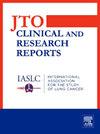Turtle Study: A Phase 2 Study of Durvalumab Plus Carboplatin and Etoposide in Elderly Patients With Extensive-Stage SCLC (LOGiK 2003)
IF 3.5
Q2 ONCOLOGY
引用次数: 0
Abstract
Introduction
The combination of immune checkpoint inhibitors with chemotherapy is the standard treatment for extensive-stage (ES) SCLC. However, its safety for elderly patients is not fully validated. We evaluated the safety and efficacy of durvalumab plus carboplatin and etoposide in elderly patients with ES-SCLC.
Methods
In this prospective, single-arm, multicenter, phase 2 clinical trial, patients with ES-SCLC aged above or equal to 75 years received chemotherapy with up to four cycles of durvalumab 1500 mg on day 1, carboplatin at a dose equivalent to an area under the curve of 5 on day 1, and etoposide 80 mg/m2 on days 1 to 3 every 3 weeks as induction therapy. Maintenance therapy with durvalumab 1500 mg was administered every 4 weeks until disease progression or unacceptable toxicity. The primary end point was safety, and key secondary end points were objective response rate, progression-free survival, overall survival, quality of life, and Geriatric Assessment.
Results
Between August 2021 and February 2023, 40 patients were enrolled at 17 institutions and 38 were assessable for safety and efficacy. Grade 3 or higher adverse events occurred in 36 patients (94.6%). The most common adverse events were hematologic, including grade 3 or higher neutropenia (76.3%) and febrile neutropenia (15.8%). The objective response rate, median progression-free survival, and median overall survival were 89.5%, 5.4 months, and 16.1 months, respectively. No decrease in quality of life or functional assessment scores was observed after treatment.
Conclusion
Durvalumab plus carboplatin and etoposide was tolerable and expected to be effective in elderly patients with ES-SCLC.
海龟研究:Durvalumab联合卡铂和依托泊苷治疗老年大分期SCLC患者的2期研究(LOGiK 2003)
免疫检查点抑制剂联合化疗是广泛期(ES) SCLC的标准治疗方法。然而,其对老年患者的安全性尚未得到充分验证。我们评估了durvalumab联合卡铂和依托泊苷治疗老年ES-SCLC患者的安全性和有效性。方法在这项前瞻性、单臂、多中心、2期临床试验中,年龄大于或等于75岁的ES-SCLC患者接受了长达4个周期的化疗,第1天为durvalumab 1500mg,第1天为卡铂,剂量相当于曲线下面积5,第1天为依托泊苷80mg /m2,每3周为第1天至第3天作为诱导治疗。每4周给予durvalumab 1500mg维持治疗,直到疾病进展或不可接受的毒性。主要终点是安全性,关键次要终点是客观缓解率、无进展生存期、总生存期、生活质量和老年评估。结果在2021年8月至2023年2月期间,来自17家机构的40名患者入组,其中38名患者可进行安全性和有效性评估。36例(94.6%)患者发生3级或以上不良事件。最常见的不良事件是血液学,包括3级及以上的中性粒细胞减少(76.3%)和发热性中性粒细胞减少(15.8%)。客观缓解率、中位无进展生存期和中位总生存期分别为89.5%、5.4个月和16.1个月。治疗后未观察到生活质量或功能评估评分下降。结论durvalumab联合卡铂和依托泊苷治疗老年ES-SCLC患者是可耐受的,且有望有效。
本文章由计算机程序翻译,如有差异,请以英文原文为准。
求助全文
约1分钟内获得全文
求助全文
来源期刊

JTO Clinical and Research Reports
Medicine-Oncology
CiteScore
4.20
自引率
0.00%
发文量
145
审稿时长
19 weeks
 求助内容:
求助内容: 应助结果提醒方式:
应助结果提醒方式:


